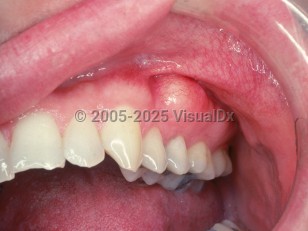Oral exostoses - Oral Mucosal Lesion
Alerts and Notices
Important News & Links
Synopsis

Exostoses are benign localized bony protuberances of the maxilla and mandible. A form of exostosis on the midline of the palate is referred to as torus palatinus and on the lingual mandible as torus mandibularis.
Exostoses are generally noted in adults and there is no sex predilection. Exostoses occur often but not always in a symmetric distribution. However, solitary exostoses are not uncommon (eg, on the right or left of the maxillary tuberosity).
Patients are often unaware of the presence of such exostoses since they have usually been present for a long time and grow very slowly.
Some cases exhibit a "growth spurt" and patients become aware of a fairly rapidly enlarging mass.
Genetic and environmental factors (such as chronic irritation) likely play a role in the development of these lesions. Some tori may also regress or become smaller over time. Exostoses may also develop as a benign bony response to irritation (eg, beneath a pontic sub-pontine exostosis).
They are usually painless unless the areas are traumatized by mastication; since they protrude, this is a fairly frequent occurrence.
Exostoses are generally noted in adults and there is no sex predilection. Exostoses occur often but not always in a symmetric distribution. However, solitary exostoses are not uncommon (eg, on the right or left of the maxillary tuberosity).
Patients are often unaware of the presence of such exostoses since they have usually been present for a long time and grow very slowly.
Some cases exhibit a "growth spurt" and patients become aware of a fairly rapidly enlarging mass.
Genetic and environmental factors (such as chronic irritation) likely play a role in the development of these lesions. Some tori may also regress or become smaller over time. Exostoses may also develop as a benign bony response to irritation (eg, beneath a pontic sub-pontine exostosis).
They are usually painless unless the areas are traumatized by mastication; since they protrude, this is a fairly frequent occurrence.
Codes
ICD10CM:
M27.8 – Other specified diseases of jaws
SNOMEDCT:
416189003 – Exostosis
M27.8 – Other specified diseases of jaws
SNOMEDCT:
416189003 – Exostosis
Look For
Subscription Required
Diagnostic Pearls
Subscription Required
Differential Diagnosis & Pitfalls

To perform a comparison, select diagnoses from the classic differential
Subscription Required
Best Tests
Subscription Required
Management Pearls
Subscription Required
Therapy
Subscription Required
References
Subscription Required
Last Updated:03/29/2017
Oral exostoses - Oral Mucosal Lesion

